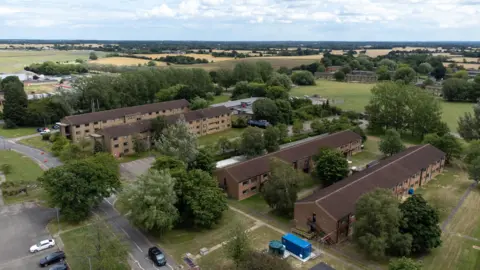### Expansion of Asylum Sites: A Strategic Shift
The ongoing discussion surrounding the accommodation of asylum seekers in the United Kingdom has entered a critical phase, particularly with new strategies aimed at addressing the growing demand for housing solutions. The government has unveiled plans to expand significant asylum centers, notably the Wethersfield air base in Essex, with the overarching objective to eliminate the reliance on taxpayer-funded hotels for asylum seekers by 2029. This move, articulated by Chancellor Rachel Reeves, is not only aimed at enhancing living conditions for refugees but also at achieving substantial cost savings for the government.
#### The Economic Perspective
Chancellor Reeves highlighted that the commitment to stop using hotels for asylum accommodation could translate to a saving of approximately £1 billion. This cost-saving initiative is deemed necessary, given that the national expenditure on asylum hotels has skyrocketed, reflecting a broader concern regarding efficient and sustainable expenditure of public funds. The initiative’s success relies heavily on transitioning asylum seekers from costly hotel stays to more affordable and structured accommodation, such as repurposed military bases or converted facilities.
In alignment with this strategic shift, it is reported that the Home Office aims to facilitate this transition through various means, including working closely with local authorities and exploring alternative housing models that promote a fairer and more efficient asylum system. Central to this strategy is the expanded use of facilities like the Wethersfield base, despite previous commitments to close it, showcasing the complex dynamics of political promises versus fiscal prudence.
#### Local Reactions and Perspectives
The announcement surrounding the potential extension of the Wethersfield facility has sparked considerable concern among local residents and representatives. Sir Keir Starmer, the leader of the opposition, previously campaigned for the closure of the facility, maintaining that its continuation would be detrimental to community welfare. Local Conservative MP Sir James Cleverly has voiced strong opposition to the government’s plans, claiming that expanding the facility disregards the legitimate concerns of constituents regarding safety and community integrity.
The situation is further complicated by reports of the former RAF base housing individuals under conditions that some have described as reminiscent of “prison-like” environments. This aspect has caught the attention of various humanitarian organizations, which assert that such living conditions are detrimental to the vulnerable populations housed there. Groups like the Helen Bamber Foundation argue that it is inhumane to confine asylum seekers, particularly those fleeing violence and persecution, in isolated and overcrowded settings lacking adequate support services.
#### The Broader Context of Asylum in the UK
According to recent Home Office figures, the number of asylum seekers in government-funded accommodation has reached around 100,000, with nearly 32,000 currently residing in hotels. This growing statistic reflects an ongoing demand for efficient handling of asylum applications, necessitating improvements in the application processing system and efforts to curb small boat crossings via the English Channel, which have significantly increased in recent months. The government’s plan is not just about managing external perceptions but also about ensuring that legal and healthcare provisions are accessible to those seeking protection.
#### Infrastructure Investments and the Future
Looking ahead, the government’s plan includes extending existing facilities and utilizing vacant student accommodation. Recent inquiries suggest that any expansion of these sites will be funded through designated investment from the Ministry of Housing, Communities and Local Government, helping the government maneuver around stringent budgetary rules set by the chancellor.
Amidst these preparations, there remains a pressing need to clarify what types of new accommodations might emerge. While there is no indication of completely new housing projects, the prospect of utilizing existing facilities signals a pragmatic approach to an increasingly complex asylum situation. It remains to be seen whether the strategies implemented will effectively alleviate pressures on currently overburdened systems or instead exacerbate local tensions.
As the government works toward achieving its objective of a £1 billion savings target, the nuances of this transition will likely play a significant role in shaping both public sentiment and the lived experiences of asylum seekers across the UK. The balance between fiscal responsibilities and humanitarian obligations presents an ongoing challenge that necessitates careful navigation in the months to come.



